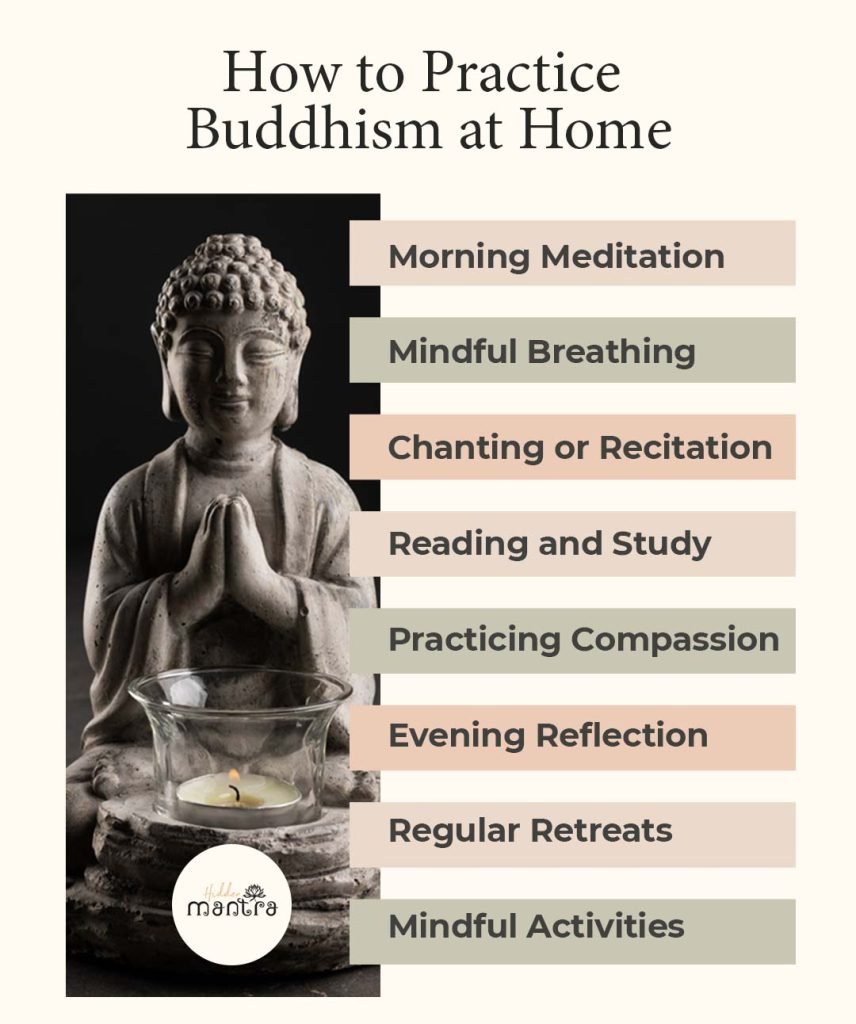Table of Contents
ToggleBuddhism at Home
In the fast-paced modern world, the quest for inner peace has led many to explore the serene path of Buddhism. In this beginner’s guide, we delve into the art of practising Buddhism at home – a journey of self-discovery, mindfulness, and enlightenment that can be embarked upon right where you are. Discover how simple yet profound practices can be seamlessly integrated into your daily life, creating a sanctuary of tranquillity amidst the chaos.
How to Practice Buddhism at Home – Activity Guide
Activity 1: Morning Meditation
Activity 2: Mindful Breathing
Activity 3: Chanting or Recitation
Activity 4: Reading and Study
Activity 5: Practicing Compassion
Activity 6: Evening Reflection
Activity 7: Regular Retreats
Activity 8: Mindful Activities
Experience the peace of practising Buddhism at home through these 8 carefully explained activities. Find and engage in each practice to nurture mindfulness and inner peace.

Activity 1: Morning Meditation
As the sun rises and a new day dawns, embark on a tranquil journey within through the practice of morning meditation. This activity invites you to set the tone for your day with a few moments of stillness and self-awareness.
Step-by-Step Guide for Morning Meditation
Step 1 – Find Your Comfortable Seat, Take a seat in a quiet and peaceful space. You can sit cross-legged on the floor, on a cushion, or in a chair – whatever is comfortable for you. Ensure your back is straight and your posture relaxed.
Step 2 – Close Your Eyes: Gently close your eyes and let go of external distractions. Allow your focus to turn inward.
Step 3 – Shift Your Awareness to Your Breath: Direct your attention to your breath. Feel the natural rhythm of your inhalations and exhalations. Notice how your chest and abdomen rise and fall with each breath.
Step 4 – Cultivate Mindfulness: As you breathe, observe any thoughts, sensations, or emotions that arise. Be a gentle witness to whatever comes up, without judgment. If your mind wanders, gently guide it back to the sensation of your breath.
Begin with 5-10 Minutes, Start your meditation with a modest duration, perhaps 5-10 minutes. This short span is enough to introduce you to the practice without feeling overwhelmed.
Gradually Extend the Duration as you become more comfortable with the practice, gradually increase the duration of your meditation sessions. You might find yourself naturally drawn to longer periods of stillness as you experience its benefits.
Morning meditation serves as an opportunity to cultivate mindfulness and inner stillness right from the start of your day. By dedicating a few moments to observe your breath and detach from the chatter of the mind, you create a precious space for self-reflection and self-care. This practice can lead to increased clarity, reduced stress, and a heightened sense of presence as you move through your daily activities.
Remember that meditation is a skill that develops over time. Approach each session with patience and an open heart. Whether it’s 5 minutes or 20 minutes, the intention to connect with your inner self remains the same. As you build a consistent morning meditation routine, you’ll find that its ripple effects extend far beyond the cushion, influencing how you engage with the world around you.
Activity 2: Mindful Breathing
In the midst of a bustling day, grant yourself the gift of presence through the practice of mindful breathing. This activity invites you to step away from the rush and reconnect with the simplicity of each breath, fostering a sense of calm and awareness.
Step-by-Step Guide For Mindful Breathing
Step 1 – Choose Your Moment: Amidst your daily activities, choose moments to practice mindful breathing. It could be while you’re waiting in line, sipping your morning tea, or taking a short break from work.
Step 2 – Find a Comfortable Posture: Stand or sit comfortably. You can close your eyes or keep them softly focused – whatever feels more natural to you.
Step 3 – Direct Your Attention to Your Breath: Shift your focus to your breath. Notice the sensation of the air entering your nostrils or the rise and fall of your abdomen. There’s no need to alter your breath – just observe it as it is.
Step 4 – Be Present: As you breathe in and out, be fully present in the experience. If thoughts arise, acknowledge them without judgment and gently bring your attention back to your breath.
Step 5 – Embrace Simplicity: Embrace the simplicity of this practice. It’s a moment of respite from the constant stream of thoughts and activities, a chance to reconnect with the here and now.
Mindful breathing is a portable practice that can be woven seamlessly into your day. It serves as an antidote to the whirlwind of multitasking and distractions, offering you a brief sanctuary of awareness. By choosing to anchor your attention to your breath, you ground yourself in the present moment, fostering a state of mindful awareness.
For those starting their Buddhist journey, I highly recommend Buddhism for Beginners. It provides clear and actionable insights to help you get started.
Activity 3. Chanting or Recitation
Experience the power of sound in your spiritual practice through chanting or recitation. This activity involves repeating a simple mantra or Buddhist scripture. Chanting can be a source of tranquillity, guiding your mind towards inner peace.
Step-by-Step Guide For Chanting or Recitation
Step 1 – Select Your Chant: Choose a mantra or a short passage from Buddhist teachings. It can be as simple as “Om Mani Padme Hum” or a verse that resonates with you.
Step 2 – Set the Tone: Find a quiet space where you won’t be disturbed. Light a candle or incense if you like, creating an atmosphere of serenity.
Step 3 – Start Chanting: Begin chanting your chosen mantra or verse. You can say it aloud or repeat it silently. Let the words flow naturally.
Step 4 – Stay Present: As you chant, focus your mind on the words and their meaning. Let any distractions drift away, and immerse yourself in the chant.
Step 5 – Embrace the Stillness: Chanting creates a rhythmic pattern that can calm the mind. Allow yourself to be absorbed in the soothing vibrations of your voice or the words.
Chanting or recitation is a way to connect with the essence of Buddhist teachings through sound. The vibrations of the words have a calming effect on the mind. The practice invites you to slow down and find serenity within the rhythm of your chant.
Activity 4: Reading and Study
Dive into the ocean of Buddhist wisdom through reading and study. This activity involves spending time with Buddhist teachings, books, or online resources. Take in the insights shared by the Buddha and other enlightened beings.
Step-by-Step Guide For Reading and Study
Step 1 – Choose Your Material: Pick a book, scripture, or online resource that resonates with you. It could be the words of the Buddha, commentaries, or contemporary interpretations.
Step 2 – Create a Quiet Space: Find a peaceful place to read where you won’t be interrupted. Make it comfortable with good lighting.
Step 3 – Read with Contemplation: Read slowly and thoughtfully. Reflect on the meanings of the teachings and how they apply to your life.
Step 4 – Take Notes: Jot down key insights, questions, or reflections that arise during your reading.
Step 5 – Openness Approach your reading with an open heart and mind, ready to receive the wisdom of the ages.
Reading and studying Buddhist teachings is like nourishing your mind and spirit. The words of wisdom offer guidance on living a mindful and compassionate life. As you explore the teachings, you’re immersing yourself in the collective wisdom of those who’ve walked the path before you.
Activity 5: Practicing Compassion
Cultivate compassion in your heart and extend it to others through acts of kindness. This activity encourages you to treat yourself and all beings with empathy and care.
Step-by-Step Guide For Cultivate Compassion
Step 1 – Self-Compassion: Treat yourself with the same kindness and understanding that you would offer to a friend. It’s about being gentle and patient with yourself, especially during challenging times.
Step 2 – Kind Acts: Perform acts of kindness, no matter how small. It could be helping a friend, offering a smile, or lending a listening ear.
Step 3 – Well-Wishes: In your thoughts, extend well wishes to all beings. May they be happy, peaceful, and free from suffering.
Step 4 – Forgiveness: Practice forgiveness towards yourself and others. Let go of grudges and resentment.
When you’re kind to yourself, you build resilience and inner strength. Instead of being your own critic, you become your own supporter, which can help you navigate challenges with a more positive outlook.
Activity 6: Evening Reflection
As the day winds down, set aside a few moments for reflection. This activity involves reviewing your actions, thoughts, and emotions of the day. Cultivate gratitude and set positive intentions for the day ahead.
Step-by-Step Guide For Evening Reflection
Step 1 – Quiet Time: Find a peaceful spot where you won’t be disturbed. Dim the lights to create a soothing atmosphere.
Step 2 – Review Your Day: Reflect on your actions, both positive and challenging. Consider how you responded to different situations.
Step 3 – Practice Gratitude: Acknowledge the blessings and positive moments of the day. Allow gratitude to fill your heart.
Step 4 – Set Intentions: Think about how you’d like to approach the next day. Set positive intentions for your interactions and activities.
Evening reflection is a way to close the day with mindfulness and awareness. By reviewing your actions, you’re fostering self-awareness and accountability. Recognizing the moments you handled well and those that challenged you is a step towards personal growth.
Gratitude is a powerful practice that shifts your focus from what’s lacking to what’s abundant in your life. It nurtures contentment and a sense of fulfilment.
Activity 7: Regular Retreats
Consider dedicating time to immerse yourself in a retreat experience, either virtually or in person. Retreats offer intensive periods of meditation, study, and self-discovery.
Step-by-Step Guide For Regular Retreats
Step 1 – Explore Retreat Options: Look for virtual or in-person retreats that align with your schedule and interests.
Step 2 – Set Aside Time: Dedicate a block of time to fully engage in the retreat experience. It could be a weekend, a few days, or longer.
Step 3 – Engage Mindfully: During the retreat, participate wholeheartedly. Embrace the meditation sessions, study periods, and group discussions.
Step 4 – Stay Open: Approach the retreat with an open mind and heart. Be ready to learn, reflect, and deepen your practice.
Retreats offer a unique opportunity to step away from your daily routine and fully immerse yourself in spiritual practice. They create a space for intensive meditation, self-reflection, and learning.
During a retreat, you’re able to explore aspects of your practice that you may not have time for in your regular routine. It’s a chance to deepen your understanding of Buddhist teachings and gain insights into your own mind and heart.
Activity 8: Mindful Activities
Bring mindfulness into your daily activities, transforming ordinary tasks into opportunities for awareness. This activity encourages you to approach tasks like eating, walking, or cleaning with full attention.
Step-by-Step Guide For Mindful Activities
Step 1 – Choose an Activity: Pick a daily activity you’d like to infuse with mindfulness. It could be brushing your teeth, cooking, or even checking your email.
Step 2 – Focus Your Attention: As you engage in the activity, direct your full attention to it. Notice the sensations, sounds, and details.
Step 3 – Let Go of Distractions: If your mind wanders, gently guide it back to the activity. Let go of any thoughts about
Step 4 – Avoid Multitasking: Try to avoid doing other things simultaneously. Give your full attention to the chosen activity.
Mindful activities remind you to live in the present moment, instead of constantly thinking about the past or worrying about the future. By immersing yourself in the current experience, you’re bringing a sense of clarity and calmness to your day.
The Power of Meditation: Transforming Your Home into a Peaceful heaven :
We know modern life has its own advantages and disadvantages. Now, we humans are always going after success and completing milestones. During this journey, we often forget about how much we pay for living a successful life instead of a satisfied life. Every human life has tensions and stresses, and we consider them as part of our journey until they become a prime reason for our sleeplessness. Then we tend to give priority, or sometimes we try to neglect, which results in higher risks.
Wherever we are, ultimately, we all come back to our home; whether it’s a luxurious villa or a nice apartment, what makes a home is the comfort and peace it can provide to us. The best way to avoid all the stresses and tensions is through practising Buddhism at home. Then you might think about how to follow Buddhism, the one and easiest method is to practise meditation. We all know meditation helps us to achieve mindfulness in our lives. By achieving mindfulness, one can be in the present and be able to be aware of what is happening around us and what we are doing. It helps us to take the right decision which is not influenced by any emotions.
Practising meditation demands a sacred space and it can be created at our home. You don’t have to buy a new space for it; instead it is all about staying away from all the distractions and stresses of the outside world to involve in Buddhist practices. Transforming your home into a peaceful one using the power of meditation helps you to recharge helps you to improve your relationships, enhance concentration, and ultimately benefits in a peaceful way of life.
Practicing Buddhism in daily life
Practising Buddhism at home can bring tremendous positive change to your life. We already know that meditation helps us to achieve mindfulness. Let’s have a look at the other Buddhist practices.

1.Interdependence
We humans are social animals. The only way to grow is through depending on others. Similarly, the actions we do and the decisions we take have a huge impact on ourselves and the others around us.
2.Following the Noble Eightfold Path
By following the Noble Eightfold Path helps you to live in harmony.
3.Embracing Difficult emotions
Try to accept difficult emotions, for example, fear. It is one of the important principles of Buddhism.
4.Compassion
Keeping compassion in your life will help you to stay away from suffering.
These are the daily Buddhist practices you can follow at home to lead a peaceful life. Try to practise Buddhism at home to have a positive impact on the physical, mental and spiritual levels.
Ready to start your journey? Grab your copy of Buddhism for Beginners on Amazon today!
Conclusion
Combining the importance of “How to Practice Buddhism at Home” into your daily life has the potential to be truly transformative. Through the curated activities of morning meditation, mindful breathing, compassionate practices, and more, Hidden Mantra serves as your guiding light.



















One Response
Very interesting